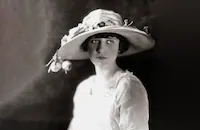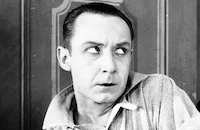Girls' School
Brief Synopsis
Cast & Crew
John Brahm
Anne Shirley
Nan Grey
Ralph Bellamy
Dorothy Moore
Gloria Holden
Film Details
Technical Specs

Synopsis
At Magnolia Hall, class monitor Natalie Freeman, who attends school on a scholarship, sees classmate Linda Simpson sneak into her room after curfew. Later, Linda tells her roommate, Betty Fleet, who cannot keep a secret, that she is engaged to Edgar, who is a poet, and that they plan to elope. Then, Miss Laurel and Miss Honore Armstrong force Natalie to turn Linda in and she is confined to her room. The dean, Miss Brewster, whom the girls call "The Duchess," summons Linda's parents. Natalie learns that they are separated and, to keep Linda from being humiliated, she meets Linda's father Alfred at the school entrance and asks him to wait for Linda's mother so that they can enter the school together. Miss Brewster urges the couple not to be too hard on Linda, who later tells them that Natalie is her enemy. Before the Simpsons leave, they agree to return together for Linda's graduation. On the night of the prom, Linda receives a bridal bouquet from Edgar, which she carries with her, and a corsage from her father, which she leaves in her room. Unknown to Linda, Mr. Simpson sends Natalie an identical corsage. At the dance, when Linda sees Natalie wearing the corsage, she accuses Natalie of having stolen hers. In response, Natalie slaps Linda, and when Miss Brewster demands that Natalie apologize, she runs away. Natalie's escort, George McClellan, a young boy from her hometown, finds her and after hearing her sob because she does not fit in, he asks her to marry him. Meanwhile, as Linda dresses for her elopement, she sees her father's nosegay still in her room. Realizing her error, Linda decides to postpone her marriage in order to save Natalie from expulsion. Then, Linda goes to Natalie's room and they both decide to stay in school, graduate and become friends.

Director

John Brahm
Cast

Anne Shirley
Nan Grey

Ralph Bellamy
Dorothy Moore

Gloria Holden

Marjorie Main

Margaret Tallichet
Peggy Moran
Kenneth Howell
Noah Beery Jr.

Cecil Cunningham

Pierre Watkin

Doris Kenyon
Heather Thatcher
Virginia Howell
Joanne Tree

Martha O'driscoll
Sherrie Overton

Franklin Pangborn
Marjorie Deane
Maxine Conrad

Marjorie Lord
Jean Lucius
Bertha Priestley
Shirley Mclellan

Ann Doran
George Offerman Jr.
Charles Hart
Stanley Brown
Eddie Fetherston
Harry Bernard
Richard Fiske
Beatrice Blinn
Beatrice Curtis
Crew
Lionel Banks
Arthur Black
George Cooper
Stephen Goosson
Babs Johnstone
Wallace Macdonald
Samuel Marx
Otto Meyer
Franz Planer
Richard Sherman
Tess Slesinger
Morris Stoloff
Gregory Stone

Videos
Movie Clip



Film Details
Technical Specs

Award Nominations
Best Score
Articles
Girls' School (1938)
Anne Shirley had been a very successful child actress in films beginning in 1922, under the name Dawn O'Day. Her breakout role was as Anne Shirley in Anne of Green Gables (1934). The film was so popular that Shirley took the name of her character professionally. Most of the "high schoolers" were long past graduation. At the time that Girls' School was being shot, Shirley had just turned 20 and was married to actor John Payne, Nan Grey would turn 20 during production on July 25th and marry jockey Jack Westrope the following year, and Margaret Tallichet was 24 and married to director William Wyler. Also in the cast were Ralph Bellamy and Gloria Holden as teachers, Cecil Cunningham as the headmistress, Marjorie Main, Doris Kenyon and Noah Beery, Jr., best remembered today as James Garner's father on The Rockford Files. Franklin Pangborn and Ann Doran are listed in studio records as appearing in the film but are not visible in the final print.
Directed by John Brahm with a screenplay by Richard Sherman (based on a story by Tess Slesinger), Girls' School went into production under its original working title of The Romantic Age at the Columbia Studios lot on July 5, 1938 and completed filming exactly a month later on August 6th.
Anne Shirley and Nan Grey were singled out for praise by the critics, like The New York Times's Frank Nugent, who gives a surprisingly contemporary view of the film. "When one of the school's misses remains out all night with a young man--she says they were reading poetry -- they raise up the cry of scandal, then stifle it again. For honestly, she was just reading poetry. Such an approach is almost too disconcerting these vinegary days. How, after Maedchen in Uniform (1931), Club de Femmes (1936), Girls' Dormitory (1936) and similar opera, can one accept so naive a conclusion? Is it possible that nice girls actually go to boarding schools and miss having affairs with the biology instructor, or fail to smolder beneath all manner of repressions, or truly can sit on a hockey field all night, with the scent of magnolias in the air, and be content with poetry? It is a dreadful thought. We are tempted to damn the film completely by calling it 'nice.' And that, of course, is what it is: an extremely nice picture, written with a deal of tenderness and insight, performed with enchanting naturalness by a lively troupe of youngsters and directed by John Brahm with a gracious balance of light comedy and poignant, youthful tragedy."
While Girls' School was essentially a "B" picture and not important enough to do much for any of the actors' careers, the film did earn composers Morris Stoloff and Gregory Stone an Academy Award nomination for Best Music Scoring.
Producer: Wallace MacDonald, Samuel Marx
Director: John Brahm
Screenplay: Richard Sherman, Tess Slesinger
Cinematography: Franz Planer
Film Editing: Otto Meyer
Art Direction: Stephen Goosson
Music: Ben Oakland, Gregory Stone
Cast: Anne Shirley (Natalie Freeman), Nan Grey (Linda Simpson), Ralph Bellamy (Michael Hendragin), Dorothy Moore (Betty Fleet), Gloria Holden (Miss Laurel), Marjorie Main (Miss Armstrong).
BW-71m.
by Lorraine LoBianco
SOURCES:
"Girls' School Opens at the State Tomorrow" Herald-Journal 5 Mar 39
The Internet Movie Database
Nugent, Frank "The Screen: Peasant Entertainment Is 'Girls' School' at the Criterion" The New York Times

Girls' School (1938)
Quotes
Trivia
Notes
The working title for this was The Romantic Age. Morris Stoloff and Gregory Stone were awarded an Academy Award nomination for their musical score. According to modern sources, Tess Slesinger's original novella was based on her experiences as a private school teacher.














